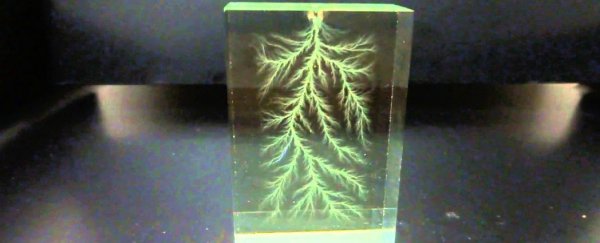Up to 24,000 people around the world die every year from lightning-related incidents, so you might think this natural phenomenon is something to be feared and avoided. That's not always the case, however. For example, check this out:
This is an example of what is called a Lichtenberg figure, which occurs when an electrical charge - like a bolt of lightning - strikes a type of material and gets trapped.
The material can be made of any type of insulating substance - like glass, acrylic, or even human flesh. By nature, insulators are poor conductors of electricity, so how do you get them to host such a powerful electric charge like lightning? The simple yet counterintuitive answer is that you transform them from a poor conductor into a good one.
To understand how this works, think about how a lightning bolt forms in the sky:
You need two oppositely charged ends, like a negatively charged cloud and the positively charged ground. When the charges grow strong enough they generate a powerful discharge in a brilliant display of white, heated gas.
In the example above, someone has placed an insulating material (most likely glass or acrylic) under a device called a cathode ray tube, which produces a powerful beam of negatively charged electrons traveling at 99 percent the speed of light.
In order to get the electrons to discharge inside of the glass or acrylic, you must first insert charged particles into the material through a process called irradiation.
Then, that sets up the same conditions that lead to a lightning strike: When the electrons from the cathode ray meet the charged portions of the insulating material, those portions instantly become electrically conductive and you get a miniature, but powerful, lightning strike.
This article was originally published by Business Insider.
More from Business Insider:
